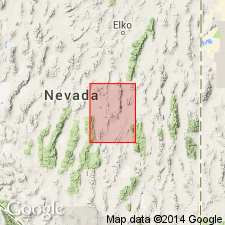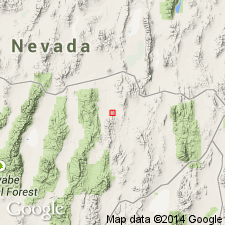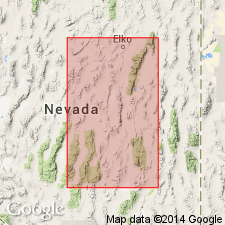
- Usage in publication:
-
- Sentinel Mountain dolomite member*
- Modifications:
-
- Named
- Dominant lithology:
-
- Dolomite
- AAPG geologic province:
-
- Great Basin province
Summary:
Takes its name from Sentinel Mountain at head of Oxyoke Canyon [39 deg 26' 02"N, 115 deg 52' 37"W, Pinto Summit 15' quad, White Pine Co, NV]. [no type designated]. Is third lowest member of Nevada Formation. Extensively exposed in south and west flank of Diamond Mountains, north of Black Point, and in Newark Mountains. Entirely composed of dolomite and typically exhibits an alternation of light- and dark-colored beds. The light-gray beds are thick bedded and are commonly coarse grained and more saccharoidal in texture than the darker dolomite interbedded with them. Mottling and a faint lamination are characteristic of the darker dolomite. Thickness variable, ranges from 410 to 590 ft. Contacts gradational between overlying Woodpecker limestone member (new) and underlying Oxyoke Canyon sandstone member (new). Contains small corals similar to CLADOPORA. Age is Middle Devonian.
Source: GNU records (USGS DDS-6; Menlo GNULEX).

- Usage in publication:
-
- Sentinel Mountain Dolomite Member*
- Modifications:
-
- Areal extent
- AAPG geologic province:
-
- Great Basin province
Summary:
Recognized in southern end of Sulphur Spring Range, Eureka Co, NV. Equivalent to unit 3 of Nevada Formation in Lone Mountain area. Age is Middle Devonian.
Source: GNU records (USGS DDS-6; Menlo GNULEX).

- Usage in publication:
-
- Sentinel Mountain Dolomite*
- Modifications:
-
- Revised
- AAPG geologic province:
-
- Great Basin province
Summary:
"Because ... every member of the Nevada Formation possesses all the characteristics of a formation, we here elevate each of its members to formation rank and abandon the name Nevada Formation". [authors do not address the Nevada Formation where it is not subdivided into members.]
Source: GNU records (USGS DDS-6; Menlo GNULEX).

- Usage in publication:
-
- Sentinel Mountain Dolomite*
- Modifications:
-
- Revised
- AAPG geologic province:
-
- Great Basin province
Summary:
In "transitional area" which includes Modoc Peak, Sulphur Spring Range and Pinyon, Sentinel Mountain Dolomite replaces Telegraph Canyon Member of Carlisle and others (1957). Overlies Oxyoke Canyon Formation.
Source: GNU records (USGS DDS-6; Menlo GNULEX).
For more information, please contact Nancy Stamm, Geologic Names Committee Secretary.
Asterisk (*) indicates published by U.S. Geological Survey authors.
"No current usage" (†) implies that a name has been abandoned or has fallen into disuse. Former usage and, if known, replacement name given in parentheses ( ).
Slash (/) indicates name conflicts with nomenclatural guidelines (CSN, 1933; ACSN, 1961, 1970; NACSN, 1983, 2005, 2021). May be explained within brackets ([ ]).

